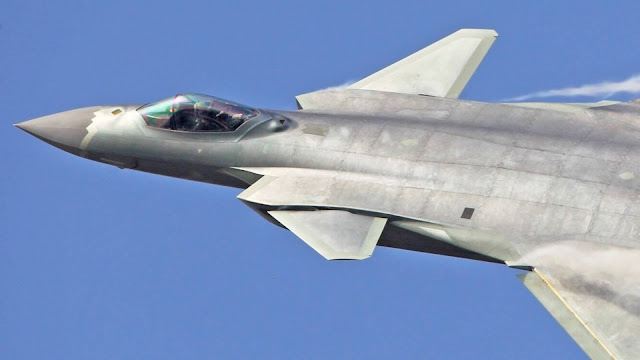China's J-20 stealth fighter spotted with four extra fuel tanks for extended range
by noreply@blogger.com (brian wang) from NextBigFuture.com on (#2DZ15)
China's J-20 stealth fighter has been seen with four auxiliary fuel tanks (aka, drop tanks or "bags") under its wings.
Although cumbersome external fuel tanks sap the J-20's low observable (stealth) qualities and maneuvering performance, it is likely that they can be jettisoned along with their pylons in a similar manner as the F-22. This allows the aircraft to recapture a large degree of its low observability, and is clearly useful if increased kinematic performance is needed. The tanks will also allow J-20s to reach stations hundreds of miles beyond what they are capable on external fuel alone. They will make the J-20 more independent of aerial tankers for certain missions, and even with four tanks, the J-20's baseline internal weapon carriage capability is not disturbed.
The J-20, or a least some of them will carry weapons under their wings. China's new very long-range air-to-air missile.
J-20s could work cooperatively. For instance, a devision (flight of four) J-20s could work in two sections, one section of two jets in stealth configuration, and the other two carrying four long-range air-to-air missiles. The stealthy pair can venture forward to quietly (electronic emissions silent) obtain targeting information while the J-20s carrying the long-range missiles can act as weapons magazines, leveraging the targeting data obtained from their stealthy wingmen. These are similar to tactics being developed by the USAF for the F-15 and F-22 air dominance team. For instance, the stealthy J-20s can use their passive sensors (electronic support measures and infrared search and track) to silently stalk targets far in front of the non-stealthy configured J-20s. Meanwhile the other non-stealthy J-20s operating many dozens of miles to the rear can use their radars freely, providing enhanced situational awareness to the stealthy J-20s ahead by sharing their radar "picture" via data-link. In doing so these non-stealthy configured J-20s also act as bait, drawing in enemy fighter aircraft, and leaving them vulnerable to ambush by their stealthy and silent counterparts.


Read more


Although cumbersome external fuel tanks sap the J-20's low observable (stealth) qualities and maneuvering performance, it is likely that they can be jettisoned along with their pylons in a similar manner as the F-22. This allows the aircraft to recapture a large degree of its low observability, and is clearly useful if increased kinematic performance is needed. The tanks will also allow J-20s to reach stations hundreds of miles beyond what they are capable on external fuel alone. They will make the J-20 more independent of aerial tankers for certain missions, and even with four tanks, the J-20's baseline internal weapon carriage capability is not disturbed.
The J-20, or a least some of them will carry weapons under their wings. China's new very long-range air-to-air missile.
J-20s could work cooperatively. For instance, a devision (flight of four) J-20s could work in two sections, one section of two jets in stealth configuration, and the other two carrying four long-range air-to-air missiles. The stealthy pair can venture forward to quietly (electronic emissions silent) obtain targeting information while the J-20s carrying the long-range missiles can act as weapons magazines, leveraging the targeting data obtained from their stealthy wingmen. These are similar to tactics being developed by the USAF for the F-15 and F-22 air dominance team. For instance, the stealthy J-20s can use their passive sensors (electronic support measures and infrared search and track) to silently stalk targets far in front of the non-stealthy configured J-20s. Meanwhile the other non-stealthy J-20s operating many dozens of miles to the rear can use their radars freely, providing enhanced situational awareness to the stealthy J-20s ahead by sharing their radar "picture" via data-link. In doing so these non-stealthy configured J-20s also act as bait, drawing in enemy fighter aircraft, and leaving them vulnerable to ambush by their stealthy and silent counterparts.


Read more